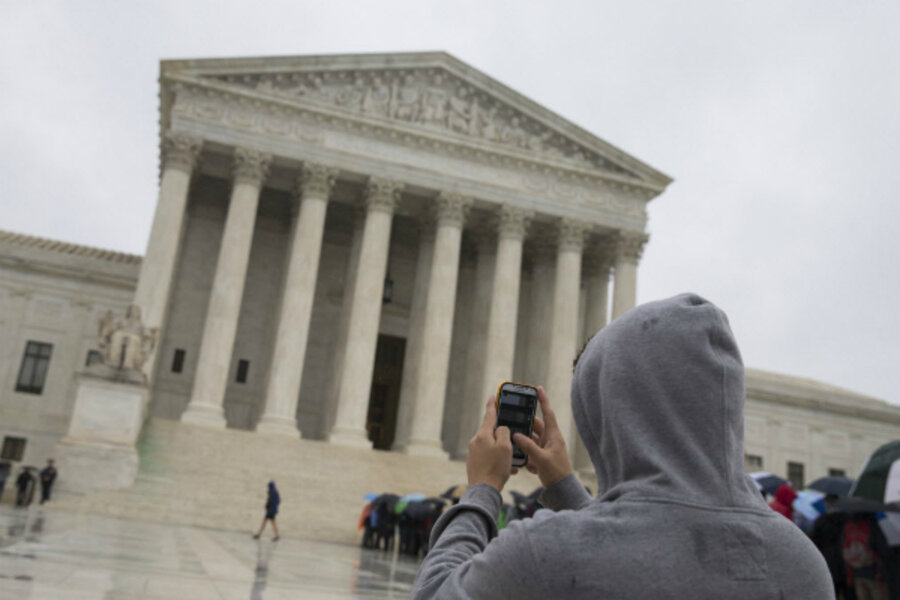Split Supreme Court shoots down 'straw' gun purchases
| WASHINGTON
The US Supreme Court on Monday upheld the conviction of a former police officer who purchased a $400 Glock handgun for his uncle but failed to disclose his role as a straw purchaser on federal firearms disclosure forms.
The 5-to-4 decision is important because it embraces a broad reading of the disclosure requirements in federal gun regulations.
The decision comes at a time of heightened public concern about mass shootings in the US and finding ways to prevent weapons from falling into the wrong hands.
The case before the high court involved a Virginia man, Bruce Abramski, who was sentenced to five years probation for claiming that he was the actual buyer of the weapon.
Mr. Abramski’s lawyers argued on appeal that he was wrongly convicted because his role in the purchase was not material to the lawfulness of the sale.
They argued that Abramski and his uncle, Angel Alvarez of Pennsylvania, were both legally eligible to purchase and possess firearms and that it didn’t matter whether Abramski made the purchase or Alvarez did so.
Abramski said he was involved in the purchase in an attempt to obtain a law enforcement discount for the firearm and pass the savings on to his uncle.
The uncle sent a check for the $400 purchase price. Abramski later transferred the gun to his uncle at a federally licensed gun dealer.
Nonetheless, federal prosecutors said Abramski committed a federal crime during the purchase because he failed to disclose on forms that he was not the actual purchaser of the weapon.
In a 5-to-4 ruling, the high court agreed with the prosecutors that Abramski’s actions violated federal firearms statutes.
“No piece of information is more important under federal firearms law than the identity of a gun’s purchaser,” Justice Elena Kagan wrote in the majority opinion. “Had Abramski admitted that he was not that purchaser, but merely a straw … the sale here could not have gone forward.”
Justice Kagan said Abramski’s misrepresentation on the federal form was, therefore, material to the lawfulness of the transaction.
In a dissent, Justice Antonin Scalia said Abramski’s false statement was not material to the lawfulness of the sale because both Abramski and his uncle could have lawfully purchased the weapon.
He said the government and the majority justices engaged in a strained interpretation of the statute to render Abramski’s conduct illegal.
The key question is: Who was the purchaser – the uncle who sent $400 for the gun or Abramski who entered the gun shop and exchanged money for the firearm?
Kagan and the majority justices said the real purchaser was the uncle. Scalia and the dissenting justices said the purchaser was Abramski.
Scalia said his interpretation was supported by plain language and ordinary usage. “If I give my son $10 and tell him to pick up milk and eggs at the store, no English speaker would say that the store 'sells' milk and eggs to me,” Scalia said.
He also said that there was nothing under federal firearms laws that would have prevented Abramski from purchasing the weapon under his own name and then giving it as a gift to his uncle or reselling it for the same price to his uncle.
The majority embraced a broader reading of the gun regulations. Part of the purpose of the disclosure law was to head off straw purchases that might conceal the identity and other required information about the true buyer.
“The firearms law contemplates that the dealer will check not the fictitious purchaser’s but instead the true purchaser’s identity and eligibility for gun ownership,” Kagan said. “By concealing that Alvarez was the actual buyer, Abramski prevented the dealer from transacting with Alvarez face-to-face, recording his name, age, and residence, inspecting his photo ID, submitting his identifying information to the background check system, and determining whether he was prohibited from receiving a firearm.”
“In sum,” Kagan said, “Abramski thwarted application of essentially all of the firearms law’s requirements. We can hardly think of a misrepresentation any more material to a sale’s legality.”
Gun control advocates praised Kagan’s opinion. “This is a very big and very positive decision that will save lives by keeping guns out of the hands of dangerous people,” Dan Gross, president of the Brady Center to Prevent Gun Violence, said in a statement.
“Once again the Supreme Court rejected efforts by the corporate gun lobby to undermine federal gun laws, reaffirming that sensible laws can have a big impact while being consistent with the Second Amendment,” he said.
Federal background checks are required under a statute known as the Brady law, so named because of the Brady Center’s efforts in passing it.
“The Supreme Court has properly recognized that federal law requires that those who intend to buy a gun from a licensed gun dealer cannot circumvent the Brady law by using a straw purchaser, but must submit to a Brady brackground check,” Jonathan Lowy, also of the Brady Center, said in a statement.
Other analysts were critical of the majority ruling.
“Five members of the Supreme Court have decided to make it a federal crime for a lawful gun owner to buy a firearm for another lawful gun owner. No federal statute says any such thing,” Nelson Lund, a professor at George Mason University School of Law, said in a statement.
“The justices are once again legislating from the bench, which violates the Constitution, and enacting a retroactive criminal law, which is even worse,” he said.
Joining Kagan in the majority were Justices Anthony Kennedy, Ruth Bader Ginsburg, Stephen Breyer, and Sonia Sotomayor.
Joining Scalia’s dissent were Chief Justice John Roberts and Justices Clarence Thomas and Samuel Alito.
The case was Abramski v. United States (12-1493).






